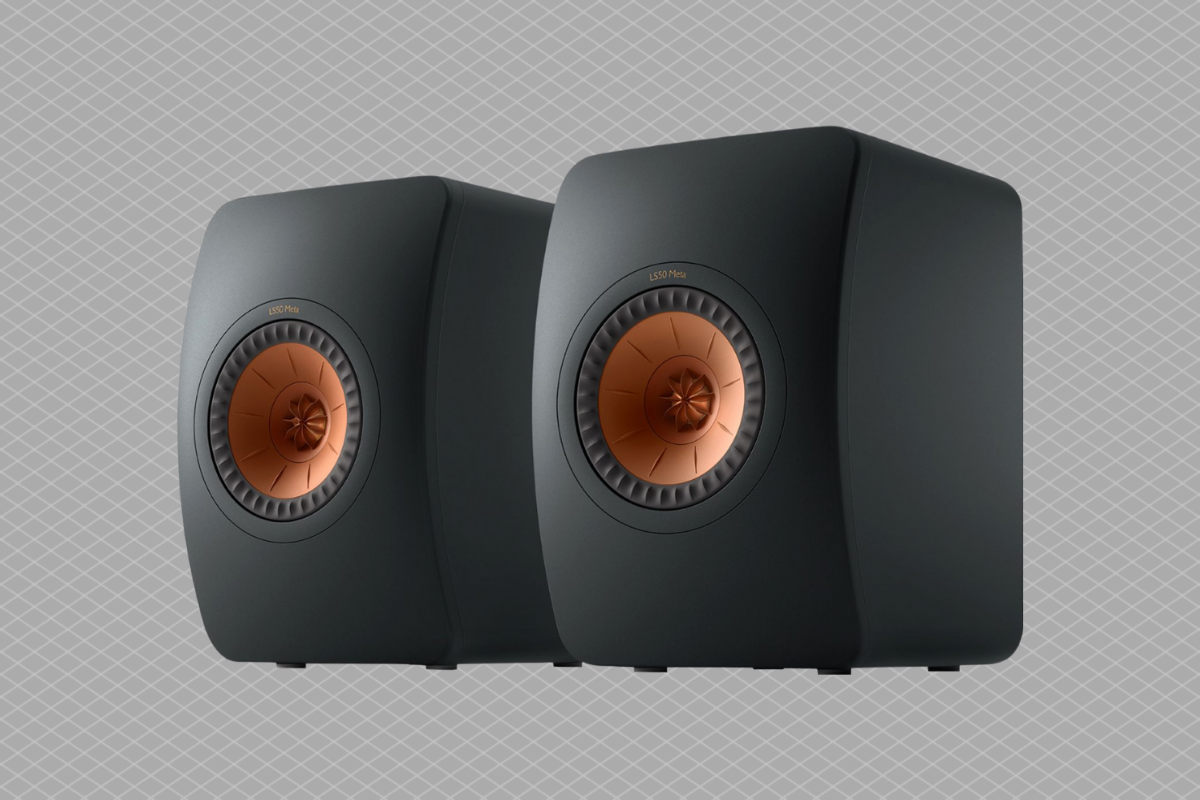TL;DR
These remarkably balanced and transparent speakers set a new standard at the price point. Just make sure you pair them with high quality amplification.
Intro
As a long-time owner (and fan) of Kef’s legendary LS50 mini-monitor, I was intrigued when I heard they were coming out with a sequel.
Dubbed the LS50 Meta ($1599.99), Kef promised the new version of this compact bookshelf would be more accurate and immersive than the original via a new technology called MAT (Metamaterial Absorption Technology).
Of course, as someone very familiar with the original LS50, I wondered, was the LS50 Meta really that much of an upgrade?
I mean, the ones I already had were pretty darn accurate and immersive, providing listeners with astounding soundstage, imaging, and scale for its size. When I bought them, they were considered the reference monitor for around a thousand dollars.
I finally got my hands on a pair of LS50 Metas, and I was super excited to find out just how much of an improvement these new LS50s were.
So if you have the original LS50s, should you upgrade? Is the new LS50 still an affordable reference in today’s market? Well, read on, and I’ll let you know the scoop!
Disclaimer: The review unit I have on hand is provided by Kef in exchange for our evaluation. No input has been given regarding the content contained within.
Specs
- Design: Two-way bass reflex
- Crossover frequency: 2.1 kHz
- Frequency range (-6dB): 47 Hz – 45 kHz
- Maximum output: 106 dB
- Amplifier power (recommended): 40-100 W
- Nominal impedance: 8 Ω (min. 3,5 Ω)
- Sensitivity (2.83V/1m): 85 dB
- Dimensions (HWD per speaker): 12 x 7.9 x 12.2 in.
Build
The first LS50 speaker was released back in 2012 to celebrate KEF’s 50th anniversary, and over the years, it has become iconic, drawing accolades from just about all of the audio press.
Then in 2020, Kef decided it was time for a refresh, implementing several improvements, most notably the introduction of Metamaterial Absorption Technology (MAT). By the way, metamaterials are a unique assembly of composites put together to exhibit particular properties.
In the case of MAT, Kef has created a synthetic material that can absorb unwanted sound emanating from the rear of the LS50 Meta’s driver, thus reducing distortion and enhancing the speaker’s transparency.
Kef claims the technology is capable of eliminating 99% of high-frequency distortion. They also claim 40% more frequency response smoothness over the original, a pain point for some folks on the first version.
In practice, Kef has installed a MAT driver array (basically a disk made of metamaterial) behind the Meta’s Uni-Q driver to soak up unwanted resonances. This disk also incorporates a maze-like pattern to enhance absorption properties.
Besides MAT, Kef has newly instituted several other design elements like “Driver Performance Optimisation” for reduced coloration overall and new cabinet cross bracing for prime cabinet rigidity. A quick knock test will attest to this, as I received nothing but a brief “thunk” when I attempted it.

The enclosure also has Constrained Layer Damping (CLD), which refers to a separate dampening layer to reduce distortion further. They have also installed a new offset flexible port for enhanced midrange clarity.
While there’s a lot of new stuff in the Meta, there are also a lot of elements that throwback to the original LS50, like the low-diffraction, curved baffle, the Uni-Q concentric driver setup for point source perception, the 2-way crossover, and its overall compact dimensions.
The single set of five-way binding posts is also very similar (read: very basic) to the original LS50, and the Meta is again robust and weighty, just like the original.

Conversely, there are some subtle cosmetic differences to the Meta, like the new rounded inset rear panel and matte satin-like finish, which gives it a more modern look than the first LS50.
The LS50 Meta comes in four contemporary finishes, including Carbon Black, Titanium Grey, Mineral White, and a Royal Blue Special Edition. The Black matte sample I received looked good, but strangely enough, it picked up fingerprints like nobody’s business. Nothing a quick wipe couldn’t fix, however.
In essence, the overall build quality of the LS50 Meta is superb, like the original. Kef did a great job of making subtle changes to modernize the design without totally getting away from the quintessential aesthetic that made them so popular.

As far as accessories go, you get foam port bungs to facilitate closer placement to the wall and rubber feet for surface isolation. Then, of course, there’s also a user’s manual and warranty paperwork.
Sound
I put the LS50 Metas into one of my midrange reference setups for my initial sound tests, utilizing the Audiolab 6000A Play Integrated Amp/Audiolab 6000CDT CD Transport combo.
I put the speakers on 24-inch metal stands about three feet into the room from the front wall, then about three feet from the side walls. I followed the manual’s recommendation for placement and pointed the speakers straight ahead with no toe-in.
Next, I cranked up some music from Qobuz (Rediscover your music in studio quality with Hi-Res streaming and downloads on Qobuz. Get a free trial now. ) on the 6000A Play, and I immediately perceived a difference between the LS50 Metas and the LS50s I’d listened to so many times. There was a smoothness on the top end that wasn’t there with the original LS50s.

When I hooked up my old LS50s to the 6000A, a hardness in the treble made me move away from that combination pretty quick, but with the new Meta’s, all I heard was a pronounced clarity that made me sit up and take notice.
Listening to Eric Clapton’s “Unplugged,” the Metas provided the large soundstage and focused imaging that LS50s are known for, but coupled with that was greater transparency and separation that I hadn’t heard before.
I was amazed at how palpable each mix element was, just hanging in their individual little bubbles. The performance approached what I’ve heard from far more expensive British monitors like the ATC SCM 19’s, which go for more than double the price. Another thing that amazed me was the width of the sweet spot. I was able to move a few feet to the left or right without severely impacting the sound quality.

While the Audiolab/Kef paring was nice, I felt the 6000A Play’s 50 watts per channel wasn’t quite bringing out all the LS50 Meta’s dynamics (not surprising since they have a rated sensitivity of 85dB). So I moved them over to the 150 watts per channel Cambridge Audio EVO150 all-in-one amplifier ($3249), and the difference was like night and day.
This is when I felt like I was hearing the Meta’s in their full glory, as the EVO 150 brought out the punch and slam I was missing on the first system. The Meta’s played with more speed and rhythm on the Cambridge amp, and the microdynamics was breathtaking. I saw these speakers needed some significant juice to get going for real.
Listening to “Tin Pan Alley” by Stevie Ray Vaughan & Double Trouble demonstrated the dynamic prowess of these speakers. Vaughan’s guitar punctuated the “air” like he was right in the room, and even at a low volume, the atmospherics were so natural! I mean, these speakers got out of the way like no other speaker I’ve heard at its price point.

In essence, the LS50 Meta’s performance brought to mind some of the finest British mini-monitors out there, speakers like the aforementioned ATC monitors, the Harbeth P3ESR, and the speaker they are ultimately based on, the LS3/5a. The mid-range purity and atmospherics of the Metas approach these venerated examples, which cost thousands more.
I have to say “approaches” because there is a little midrange grain present in the Metas that more expensive speakers don’t have. They also don’t quite have the resolution of those more costly designs.
Additionally, you should also keep in mind that while the LS50 Metas have considerable depth and punch on the low end (for their size), they will not shake the room. If you’re looking to rock the house while playing loud hip-hop or electronica, you should probably extend the budget to account for one of Kef’s active subwoofers.
However, these characteristics do not distract from the musicality and engagement of the more affordable Meta’s, and if you’re looking for an authentic entry point into the beauty and emotion provided by British mini-monitors then these are the speakers to get!
The Wrap-Up

In the final analysis, I find the $1599.99 LS50 Metas make good on every promise given in the marketing materials. Not only are they more accurate and immersive than the originals, I see them as the ultimate realization of the LS50’s original design intent. That would be the proper evolution of the classic LS3/5a British Monitor.
I applaud Kef’s ability to move the LS50’s performance so far upscale without doubling or tripling the price. If you have the original LS50s and are thinking about swapping for the new ones, I think the improvements made are worth it. However, keep in mind the transparency of the Metas makes them less forgiving of lesser sources/amps, so you may end up switching out some other stuff also.
If you want the faithful midrange presentation of a top-notch British mini-monitor for less than 2k, this is probably the only ticket in town.
Hifitrends is reader-supported. When you purchase through links on our site, we may earn an affiliate commission. Prices are subject to change at any time.

I’m an audio writer who started as a young audio salesman/consumer electronics professional back in the late 90s. That’s where I discovered the magic of 2-Channel sound. My hunger for great sound has led me on a delightful music quest that continues today.



Leave a Reply